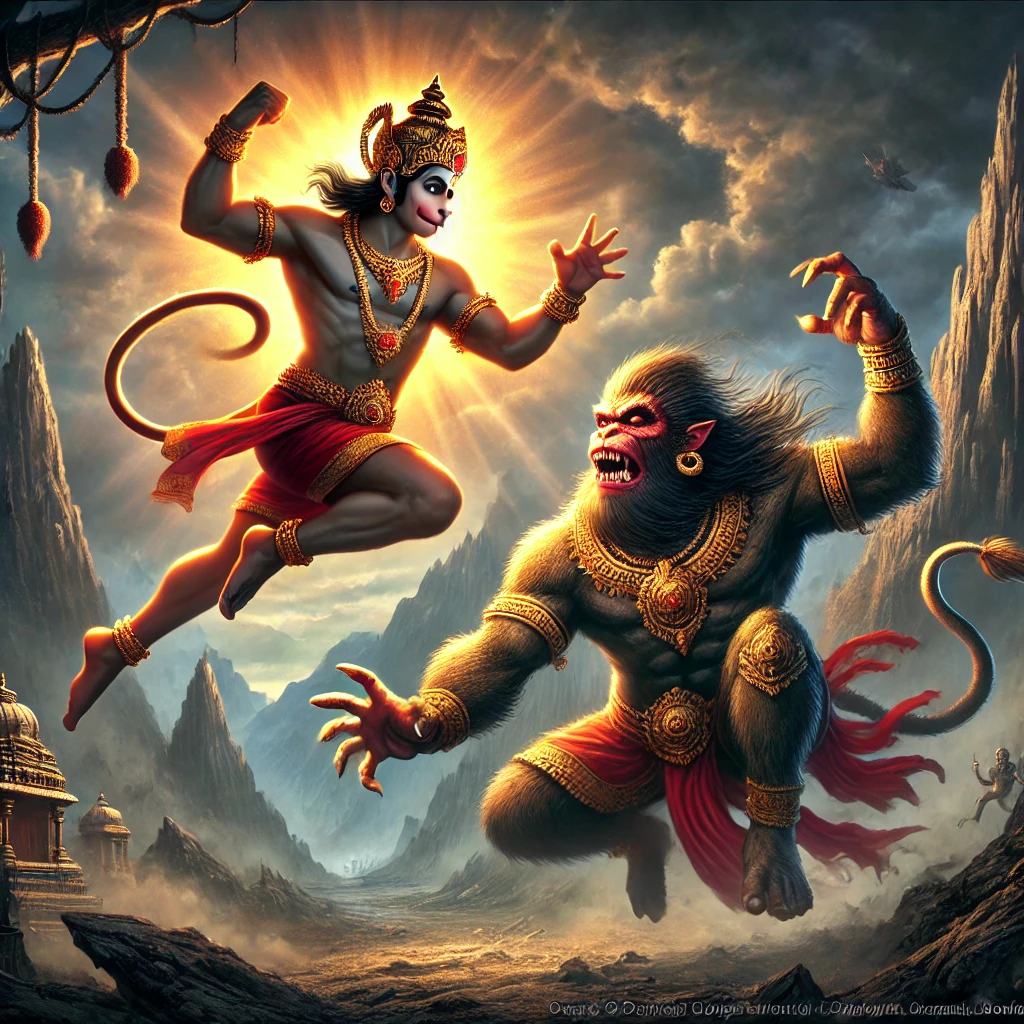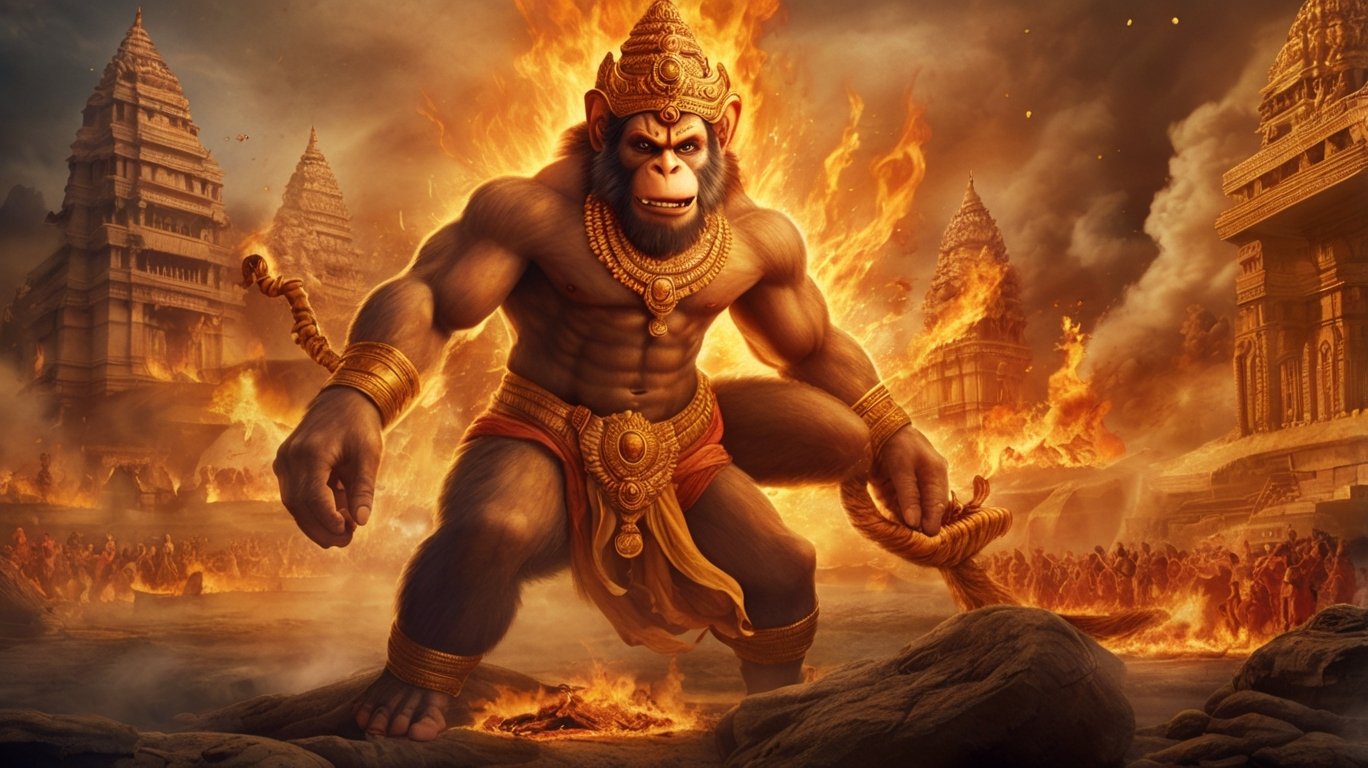Table of Contents
Welcome to Bedesii.com, your spiritual companion on the path of divine wisdom and timeless knowledge. Today, we embark on an enlightening journey through one of the most revered chapters of the Ramayana—Sundarkand Explanation in English – Part 1. Sundarkand tells the heroic tale of Lord Hanuman’s unparalleled devotion, courage, and determination as he sets out to find Sita Mata.
To make this sacred scripture more accessible, we are presenting Sundarkand in portions, verse by verse, with simple explanations. This blog post is the first in a series, where we will break down the story into smaller parts for easier reading and deeper understanding. In this post, we will cover the first nine verses, focusing on the profound moments that shaped Hanuman’s journey and his mission for Lord Rama.
Stay tuned as we continue to explore the incredible lessons and inspirations from Sundarkand in upcoming posts!
Prayer to Lord Rama – Sundarkand Explanation
Shantam Shasvatamaprameyamanaghanam nirvanashantipradam
brahmashambhuphaneendrasevyamanisham vedantavedyam vibhum,
Ramakhayam jagadishvaram suragurum mayamanusyamharim
vandeaham karunakaram raghuvaram bhupalachunamanim.
In this verse, Lord Rama is praised as the eternal, peaceful, and sinless Lord of the universe. He is beyond ordinary human understanding and is always worshipped by gods like Brahma, Lord Shiva, and Sesha Nag. He is the source of ultimate peace and liberation.
Explanation
As we begin our journey, imagine Lord Rama sitting majestically in his royal form, filled with divine grace and compassion. He is surrounded by great deities who constantly pay their respects to him. This verse reminds us of Lord Rama’s unmatched power and his calm, composed nature that brings peace to all who worship him. The beauty of this verse is that it depicts the Lord not just as a warrior but as the embodiment of serenity and divinity, showing us that true strength comes from inner peace.
nanya sprha raghupate hridayesmadiye
satyam vadami cha bhavnakhilantartma,
bhaktim prayaccha raghupungava nirbharam me,
kamadidosarahitamkuru manasam cha.
In this verse, the devotee says there is no desire in his heart except for devotion to Lord Rama. He asks Lord Rama to bless him with pure devotion and free his mind from worldly desires like lust and greed.
Explanation
Imagine yourself as a devotee standing in front of Lord Rama. Your heart is pure, and you don’t wish for anything material. You tell Lord Rama, “I don’t want any wealth or power, all I want is to serve you.” This verse reflects the purity of a devotee’s heart. In this spiritual path, devotion is everything, and nothing worldly can tempt a true devotee. Through Hanuman’s selfless service to Lord Rama, we learn that devotion must be free of desires.
Atulitabaladhamam hemashailabhadeham
danujavanakrusanum jnaninamagraganyam,
sakalagunanidhanam vanaranamadhihsam
raghupatipriyabhaktamvatajatam namami.
Meaning
This verse praises Lord Hanuman as the treasure house of immeasurable strength and as someone who has a body as strong as a mountain of gold. Hanuman is a fire to demons and the most learned among the wise. He is the leader of the monkey army and the most beloved devotee of Lord Rama.
Explanation
Now, picture the mighty Hanuman, standing tall and shining like a golden mountain. His strength is unmatched, and his wisdom is beyond comparison. He is not only a warrior but also a sage who knows the truth of the universe. His loyalty to Lord Rama is unwavering. This verse emphasizes that true power lies not just in physical strength but in loyalty and wisdom. Hanuman’s devotion to Lord Rama made him invincible, and this devotion is something we all can learn from.

Verses
- Jamavanta ke bachan suhaye, suni hanumanta hridaya ati bahe.
- Taba lagi mohi parikhehu tumha bhai, sahi dukha kanda muula phala khayi.
- Jaba lagi avau sitahi dekhi, hoihi kaju mohi harasa bisesi.
- Yaha kahi nai sabanhi kahu mth, chaleu harasi hiya dhari raghuntha.
- Simdhu tira eka bhudhara sundara, kautuk kudi chadheu ta upara.
- Bara bara raghubira sambhri, tarakeu pavanatanaya bala bhari.
- Jehi giri charan dei hanumanta, chaleu so ga patala turanta.
- Jimi amogha raghupati kar baana, ehi bhati chaleu hanumana.
- Jalanidhi raghupati duta bichari, tai mainaak hohi shrama haari.
Sundarkand Explanation in English
After Lord Rama and his army of Vanaras (monkey warriors) gathered at the shores of the great ocean, they faced the challenge of finding Sita Mata, who had been taken by Ravana. Jamavanta, the wise bear king, knew that only Hanuman, the mighty son of the wind god, possessed the strength and courage to cross the vast ocean and locate Sita. He spoke words of inspiration to Hanuman, reminding him of his unmatched abilities. (Jamavanta ke bachan suhaye, suni hanumanta hridaya ati bahe.) Hanuman, moved deeply by Jamavanta’s words, felt his heart swell with confidence and determination.
Hanuman had endured many hardships, living in the forest and surviving on roots and fruits while they searched for Sita. (Taba lagi mohi parikhehu tumha bhai, sahi dukha kanda muula phala khayi.) He had waited long for this moment, and now, his time had come to fulfill his duty. He declared to his companions that he would not return until he had seen Sita with his own eyes. This task would be accomplished, and the success of the mission would fill his heart with immense joy. (Jaba lagi avau sitahi dekhi, hoihi kaju mohi harasa bisesi.)
Without wasting any more time, Hanuman, filled with excitement and a heart devoted to Lord Rama, bid farewell to his companions and prepared to begin his great leap across the ocean. His heart was firm in his devotion to Lord Rama, and this gave him immense strength. (Yaha kahi nai sabanhi kahu mth, chaleu harasi hiya dhari raghuntha.)
As Hanuman approached the shore, he saw a majestic mountain rising out of the ocean. It was a beautiful sight, and the strong and fearless Hanuman, with a playful spirit, took a powerful leap, using the mountain as a launch point. (Simdhu tira eka bhudhara sundara, kautuk kudi chadheu ta upara.)
Time and again, Hanuman thought of Lord Rama as he flew through the air. This constant remembrance of Rama gave Hanuman an unstoppable force and filled him with a divine strength. (Bara bara raghubira sambhri, tarakeu pavanatanaya bala bhari.)
As Hanuman soared through the sky, he placed his foot on the mountain and shot forward with incredible speed. Just like an arrow released from the bow of Lord Rama never misses its target, Hanuman’s journey was sure and swift. (Jehi giri charan dei hanumanta, chaleu so ga patala turanta. Jimi amogha raghupati kar baana, ehi bhati chaleu hanumana.)
As he soared over the ocean, the gods looked upon Hanuman with admiration. Seeing his determination and devotion to Lord Rama, they decided to test his strength and help him along his way. Mainak, the golden mountain that could float on water, rose from the depths of the ocean. The mountain emerged not only to test Hanuman but also to offer him rest from his long journey, as the gods wished to ease his fatigue. (Jalanidhi raghupati duta bichari, tai mainaak hohi shrama haari.)
Doha
Hanumana tehi parasa kara puni kinha pranam,
Rama kaju kinhe binu mohi kaha bisrama.
Explanation
As Hanuman soared across the vast ocean on his quest to find Sita, his strength and determination were unparalleled. The gods and divine beings watched his journey, recognizing the enormity of his task. Mainak, the golden mountain that could float on water, rose from the ocean to offer Hanuman a place to rest. Mainak had been instructed by the gods to give Hanuman a moment of respite and recover from his tiresome journey.
Seeing the mountain rise, Hanuman knew it was a gesture of goodwill. He gently landed on Mainak and, with great respect, touched the mountain as a mark of honor. He bowed, acknowledging the kind offer. Mainak welcomed him warmly, urging Hanuman to take a break and rest for a while. After all, his journey was long and arduous, and a brief pause would refresh him.
But Hanuman, driven by his unshakable devotion to Lord Rama, humbly declined the offer. He knew that Lord Rama’s mission was far more important than his own comfort. Hanuman said, “How can I rest before completing Lord Rama’s task? I must find Mother Sita and deliver the message of hope to her. Until then, I have no desire for rest or comfort.”
With that, Hanuman left Mainak, soaring once more into the sky, driven by his devotion, courage, and determination. He knew that no obstacle, no matter how inviting or well-meaning, could deter him from his divine mission.
Key Takeaways
- Selfless Devotion: Hanuman’s commitment to serving Lord Rama was absolute. He prioritized Rama’s work above his personal needs or comfort.
- Single-Minded Focus: Despite the opportunity to rest, Hanuman’s focus on his mission never wavered. His sense of duty overshadowed any temptation to take a break.
- Respect and Humility: Although Hanuman declined the offer, he did so with great humility and respect, showing his gracious character even in the face of distraction.
This Doha reflects the essence of Hanuman’s personality — his selflessness, dedication, and unyielding devotion to Lord Rama. It serves as an inspiration for all to stay focused on their duties and divine purposes, regardless of the obstacles or distractions that come their way.
Important Events, Insights, and Entities in the Provided Verses
- Jamavanta’s Encouragement
- Event: Jamavanta, the wise bear king, reminds Hanuman of his immense strength and courage, serving as a turning point in the mission to locate Sita.
- Insight: Jamavanta’s wise words illustrate how guidance can unlock hidden potential, just as his counsel reignites Hanuman’s confidence and determination.
- Hanuman’s Determination
- Event: Strengthened by Jamavanta’s words, Hanuman vows not to return until he finds Sita, showcasing his unwavering resolve.
- Insight: Hanuman’s deep devotion to Lord Rama emphasizes the power of purpose-driven action and loyalty, inspiring determination to fulfill one’s mission no matter the challenges.
- Hanuman’s Leap Across the Ocean
- Event: Hanuman, using a mountain as his launchpad, makes a colossal leap across the ocean, displaying his unparalleled physical prowess.
- Insight: This leap symbolizes how focus, faith, and determination can help us overcome even the greatest challenges. Hanuman’s action underscores that faith and devotion bring extraordinary strength.
- Lord Rama’s Influence
- Event: Throughout his leap, Hanuman continuously remembers Lord Rama, which magnifies his strength and ensures his success.
- Insight: This highlights the importance of constant devotion and remembrance of a higher purpose, showing how divine connection strengthens and guides us during difficult times.
- Mainak Mountain’s Test and Support
- Event: Mainak, the golden mountain, rises from the ocean to offer Hanuman rest, testing his resolve on the journey. Hanuman respectfully declines, focusing on his mission.
- Insight: Divine forces often provide support and encouragement during noble pursuits. Hanuman’s refusal to rest reflects his unwavering commitment and single-minded focus on completing Lord Rama’s task.
FAQ
- Q: Who is Jamavanta, and why is his role important in this part of Sundarkand?
- Answer: Jamavanta is a wise bear king and a close ally of Lord Rama. His role is crucial as he encourages Hanuman by reminding him of his strength, motivating him to undertake the task of crossing the ocean to find Sita. Without Jamavanta’s words, Hanuman’s confidence might not have been fully awakened.
- Q: What is the significance of Hanuman’s leap across the ocean?
- Answer: Hanuman’s leap represents his incredible physical strength and unwavering determination. It is also symbolic of overcoming seemingly impossible obstacles with faith and devotion. His journey across the ocean is a testament to his single-minded focus on finding Sita for Lord Rama.
- Q: Why does Hanuman repeatedly remember Lord Rama during his journey?
- Answer: Hanuman’s constant remembrance of Lord Rama serves as a source of strength and motivation. It highlights the theme of devotion, suggesting that when one focuses on a divine or noble cause, it helps them succeed, even in the most difficult of tasks.
- Q: Who or what is Mainak, and why did it rise from the ocean?
- Answer: Mainak is a golden mountain with the ability to float on water. It rises from the ocean to offer Hanuman a place to rest during his journey and also to test his resolve. This event demonstrates the support of divine forces for Hanuman’s mission.
- Q: What is the key message conveyed through Hanuman’s refusal to rest on Mainak?
- Answer: Hanuman’s refusal to rest on Mainak shows his relentless focus and dedication to the task at hand. It conveys the message that when one is on a mission with a higher purpose, distractions or comfort should not deter them from achieving their goal.
- Q: How do these verses reflect Hanuman’s character?
- Answer: These verses showcase Hanuman’s immense strength, unwavering devotion, and single-minded dedication to Lord Rama’s mission. His humility, courage, and ability to overcome obstacles make him a symbol of selfless service and devotion.
Conculsion
In this part of Hanuman’s story, we see his unwavering devotion to Lord Rama and his readiness to face any challenge. Despite having faced hardship during the search for Sita, he now stands ready to leap across the vast ocean, his heart full of determination. His faith in Lord Rama and the inspiration from Jamavanta give him the strength to carry out this seemingly impossible task.
This journey of Hanuman reflects the incredible inner power that lies within each of us, ready to be awakened when we devote ourselves to a higher purpose, just as Hanuman devoted himself to Lord Rama’s mission.
Read Also
Sundarkand Part 2 | Sundarkand Part 3 | Sundarkand Part 4 | Sundarkand Part 5 | Sundarkand Part 6 | Sundarkand Part 7 | Sundarkand Part 8 | Sundarkand Part 9 | Sundarkand Part 10
Important Links







